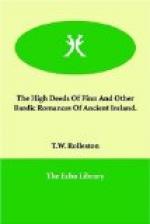[35] See the conclusion of the Vengeance of Mesgedra.
One day it happened that Cormac after he had laid down the kingship of Ireland, was present when the druids and a concourse of people were worshipping the great golden image which was set up in the plain called Moy Slaught. When the ceremony was done, the chief druid, whose name was Moylann, spoke to Cormac and said: “Why, O Cormac, didst thou not bow down and adore the golden image of the god like the rest of the people?”
And Cormac said: “Never will I worship a stock[36] that my own carpenter has made. Rather would I worship the man that made it, for he is nobler than the work of his hands.”
[36] The image was doubtless of wood overlaid with gold.
Then it is told that Moylann by magic art caused the image to move and leap before the eyes of Cormac. “Seest thou that?” said Moylann.
“Although I see,” said Cormac, “I will do no worship save to the God of Heaven and Earth and Hell.”
Then Cormac went to his own home at Sletty on the Boyne, for there he lived after he had given up the kingdom to his son Cairbry. But the druids of Erinn came together and consulted over this matter, and they determined solemnly to curse Cormac and invoke the vengeance of their gods upon him lest the people should think that any man could despise and reject their gods, and suffer no ill for it.
So they cursed Cormac in his flesh and bones, in his waking and sleeping, in his down sitting and his uprising, and each day they turned over the Wishing Stone upon the altar of their god,[37] and wove mighty spells against his life. And whether it was that these took effect, or that the druids prevailed upon some traitorous servant of Cormac’s to work their will, so it was that he died not long thereafter; and some say that he was choked by a fish bone as he sat at meat in his house at Sletty on the Boyne.
[37] There are still Wishing Stones, which are used in connexion with petitions for good or ill, on the ancient altars of Inishmurray and of Caher Island, and possibly other places on the west coast of Ireland.
But when he felt his end approaching, and had still the power to speak, he said to those that gathered round his bed:—“When I am gone I charge you that ye bury me not at Brugh of the Boyne where is the royal cemetery of the Kings of Erinn.[38] For all these kings paid adoration to gods of wood or stone, or to the Sun and the Elements, whose signs are carved on the walls of their tombs, but I have learned to know the One God, immortal, invisible, by whom the earth and heavens were made. Soon there will come into Erinn one from the East who will declare Him unto us, and then wooden gods and cursing priests shall plague us no longer in this land. Bury me then not at Brugh-na-Boyna, but on the hither-side of Boyne, at Ross-na-ree, where there is a sunny, eastward-sloping hill, there would I await the coming of the sun of truth.”




